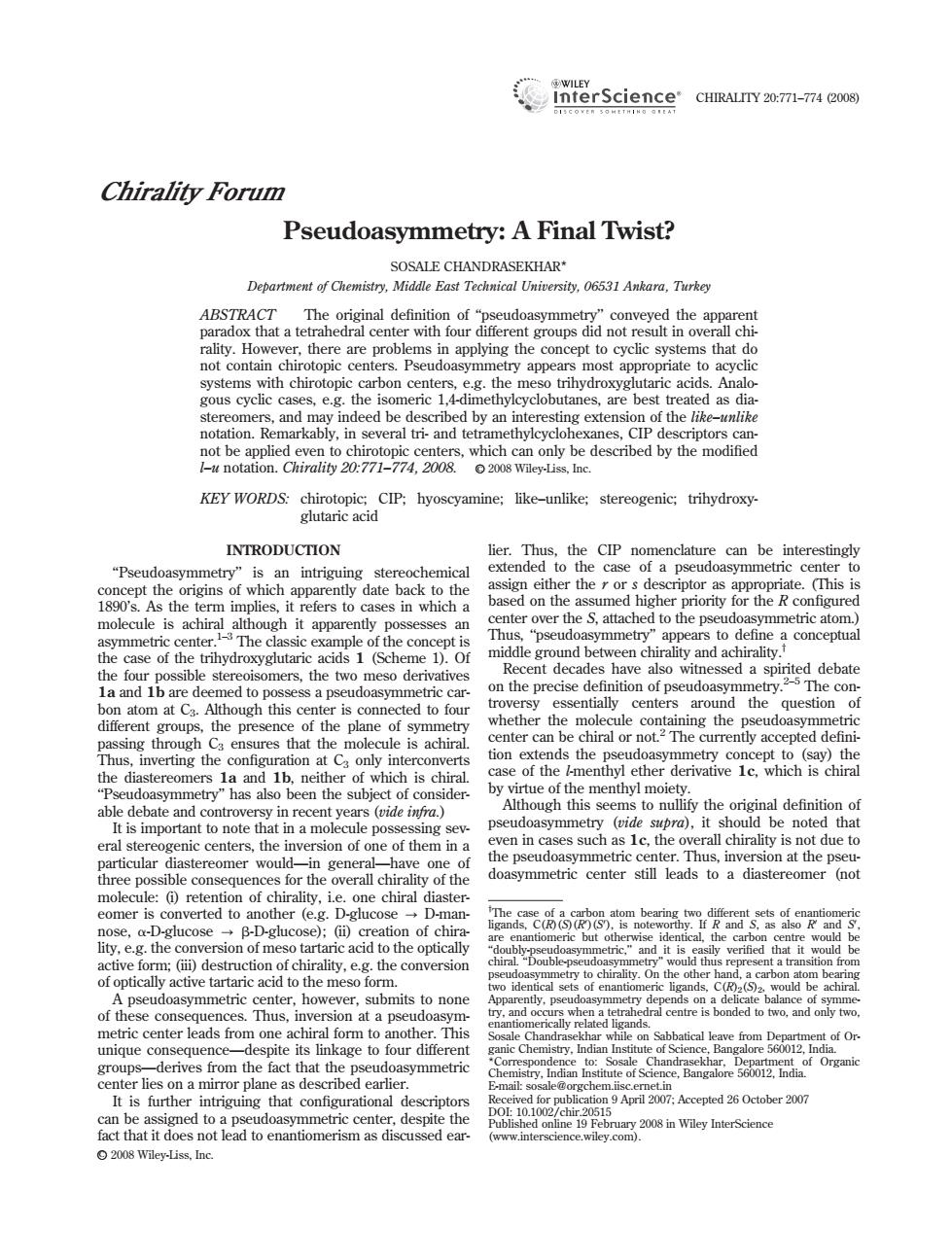正在加载图片...

interScience CHRALY 7-74 00) Chirality Forum Pseudoasymmetry:A Final Twist? SOSALE CHANDRASEKHAR Depariment of Chemistry,Middle East Tecknical University,06531 Ankara,Turkey ABSTRACT f er with four esing extension of the not be O 2008 Wiley-Liss.Ine INTRODUCTION lier.Tht the CIP no inter an in ical extended to the cas renty date back The othe con middle mers.the twe meso derivative on the precise definition of pseudoas sence of the sym whether the ining the e pr configuration a Ca only inte center can ch ase of the the der. supra),it shou note tha 之 eral s the inve 。1 ads to a stereomer (no The and e.g.the conversion bly-pseudoasymme ty.On to t wo identical set e achira se c Thus,i ion at a pse en a unique co Cha stry,In Inst Cha t is furthe 9A2 do 05 2008 Wiley-Liss.Inc. Chirality Forum Pseudoasymmetry: A Final Twist? SOSALE CHANDRASEKHAR* Department of Chemistry, Middle East Technical University, 06531 Ankara, Turkey ABSTRACT The original definition of ‘‘pseudoasymmetry’’ conveyed the apparent paradox that a tetrahedral center with four different groups did not result in overall chirality. However, there are problems in applying the concept to cyclic systems that do not contain chirotopic centers. Pseudoasymmetry appears most appropriate to acyclic systems with chirotopic carbon centers, e.g. the meso trihydroxyglutaric acids. Analogous cyclic cases, e.g. the isomeric 1,4-dimethylcyclobutanes, are best treated as diastereomers, and may indeed be described by an interesting extension of the like–unlike notation. Remarkably, in several tri- and tetramethylcyclohexanes, CIP descriptors cannot be applied even to chirotopic centers, which can only be described by the modified l–u notation. Chirality 20:771–774, 2008. VC 2008 Wiley-Liss, Inc. KEY WORDS: chirotopic; CIP; hyoscyamine; like–unlike; stereogenic; trihydroxyglutaric acid INTRODUCTION ‘‘Pseudoasymmetry’’ is an intriguing stereochemical concept the origins of which apparently date back to the 1890’s. As the term implies, it refers to cases in which a molecule is achiral although it apparently possesses an asymmetric center.1–3 The classic example of the concept is the case of the trihydroxyglutaric acids 1 (Scheme 1). Of the four possible stereoisomers, the two meso derivatives 1a and 1b are deemed to possess a pseudoasymmetric carbon atom at C3. Although this center is connected to four different groups, the presence of the plane of symmetry passing through C3 ensures that the molecule is achiral. Thus, inverting the configuration at C3 only interconverts the diastereomers 1a and 1b, neither of which is chiral. ‘‘Pseudoasymmetry’’ has also been the subject of considerable debate and controversy in recent years (vide infra.) It is important to note that in a molecule possessing several stereogenic centers, the inversion of one of them in a particular diastereomer would—in general—have one of three possible consequences for the overall chirality of the molecule: (i) retention of chirality, i.e. one chiral diastereomer is converted to another (e.g. D-glucose ? D-mannose, a-D-glucose ? b-D-glucose); (ii) creation of chirality, e.g. the conversion of meso tartaric acid to the optically active form; (iii) destruction of chirality, e.g. the conversion of optically active tartaric acid to the meso form. A pseudoasymmetric center, however, submits to none of these consequences. Thus, inversion at a pseudoasymmetric center leads from one achiral form to another. This unique consequence—despite its linkage to four different groups—derives from the fact that the pseudoasymmetric center lies on a mirror plane as described earlier. It is further intriguing that configurational descriptors can be assigned to a pseudoasymmetric center, despite the fact that it does not lead to enantiomerism as discussed earlier. Thus, the CIP nomenclature can be interestingly extended to the case of a pseudoasymmetric center to assign either the r or s descriptor as appropriate. (This is based on the assumed higher priority for the R configured center over the S, attached to the pseudoasymmetric atom.) Thus, ‘‘pseudoasymmetry’’ appears to define a conceptual middle ground between chirality and achirality.y Recent decades have also witnessed a spirited debate on the precise definition of pseudoasymmetry.2–5 The controversy essentially centers around the question of whether the molecule containing the pseudoasymmetric center can be chiral or not.2 The currently accepted definition extends the pseudoasymmetry concept to (say) the case of the l-menthyl ether derivative 1c, which is chiral by virtue of the menthyl moiety. Although this seems to nullify the original definition of pseudoasymmetry (vide supra), it should be noted that even in cases such as 1c, the overall chirality is not due to the pseudoasymmetric center. Thus, inversion at the pseudoasymmetric center still leads to a diastereomer (not Sosale Chandrasekhar while on Sabbatical leave from Department of Organic Chemistry, Indian Institute of Science, Bangalore 560012, India. *Correspondence to: Sosale Chandrasekhar, Department of Organic Chemistry, Indian Institute of Science, Bangalore 560012, India. E-mail: sosale@orgchem.iisc.ernet.in Received for publication 9 April 2007; Accepted 26 October 2007 DOI: 10.1002/chir.20515 Published online 19 February 2008 in Wiley InterScience (www.interscience.wiley.com). y The case of a carbon atom bearing two different sets of enantiomeric ligands, C(R)(S)(R0 )(S0 ), is noteworthy. If R and S, as also R0 and S0 , are enantiomeric but otherwise identical, the carbon centre would be ‘‘doubly-pseudoasymmetric,’’ and it is easily verified that it would be chiral. ‘‘Double-pseudoasymmetry’’ would thus represent a transition from pseudoasymmetry to chirality. On the other hand, a carbon atom bearing two identical sets of enantiomeric ligands, C(R)2(S)2, would be achiral. Apparently, pseudoasymmetry depends on a delicate balance of symmetry, and occurs when a tetrahedral centre is bonded to two, and only two, enantiomerically related ligands. CHIRALITY 20:771–774 (2008) VC 2008 Wiley-Liss, Inc